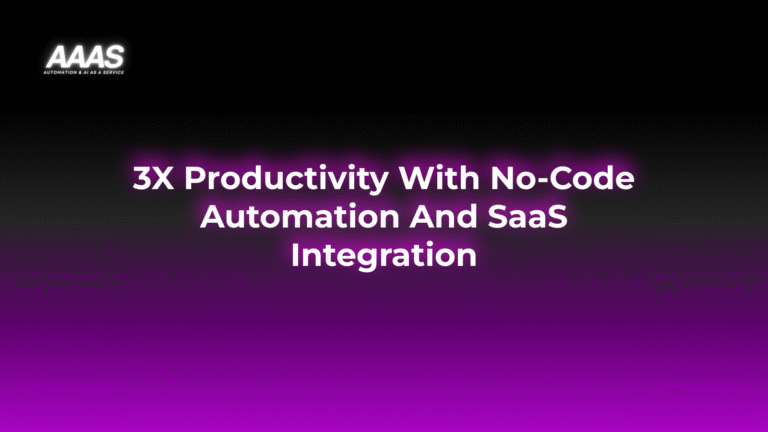Integrating No-Code Automation with SaaS Tools for Enhanced Workflow Efficiency

Market Problem: Manual SaaS Workflows Create Bottlenecks
As organizations rapidly adopt cloud-based SaaS tools for CRM, marketing, HR, and operations, teams often face fractured workflows. Employees spend hours on repetitive manual tasks—copy-pasting data, updating records, and switching contexts—leading to:
- Productivity loss and human error
- Workflow bottlenecks and silos
- Low software ROI due to underutilized features
- Delayed response times and customer frustration
Solution & Benefits: Integrating No-Code Automation
No-code automation platforms like Zapier, Make, and Workflow let business users connect SaaS apps, automate tasks, and orchestrate workflows—without writing a single line of code.
Key Benefits
- Boost productivity: Automate repetitive tasks, freeing staff for higher-value work
- Increase efficiency: Streamline multi-step workflows and reduce manual errors
- Maximize SaaS returns: Unlock new capabilities and get more value from every tool
- Enable agility: Quickly deploy new automations as business needs evolve
Real Use Cases
- Sales: Automatically create invoices in QuickBooks when a deal is closed in Salesforce
- Marketing: Sync leads from Facebook Ads to Mailchimp and notify the team in Slack
- HR: Trigger onboarding workflows in BambooHR when an offer letter is signed in DocuSign
- Customer Support: Generate a Zendesk ticket when a negative review is detected on Trustpilot
- Operations: Archive Google Drive folders and notify teams in Microsoft Teams on project completion
Technical Details: How It Works
Most no-code automation platforms use an intuitive drag-and-drop interface:
- Connect SaaS tools: Authenticate each app (e.g., Google Workspace, HubSpot, Slack)
- Define triggers: Specify events (e.g., new file uploaded, deal closed) to watch for
- Add actions: Determine what should happen (e.g., update CRM, send email)
- Set conditions/branching: Implement logic to handle different scenarios
- Monitor and report: Get analytics and error logs for ongoing optimization

Comparison with Alternatives
| Automation Method | User Profile | Setup Speed | Cost | Flexibility |
|---|---|---|---|---|
| No-Code Automation | Non-technical, business users | Fast (minutes to hours) | Low to moderate | High for standard tasks |
| Custom APIs & Scripting | Developers/IT | Slow (days to weeks) | High (dev & maintenance) | Very high |
| Native SaaS Integrations | All users | Immediate (if available) | Included | Very limited |
Pricing: Popular No-Code Automation Platforms
| Platform | Free Plan | Starter Plan | Business Plan | Enterprise |
|---|---|---|---|---|
| Zapier | Yes (100 tasks/mo) | $19.99/mo | $49/mo | Custom |
| Make | Yes (1,000 ops/mo) | $9/mo | $29/mo | Custom |
| Pabbly Connect | Yes | $19/mo | $39/mo | Custom |
Pricing as of July 2025. Always review latest pricing on vendor sites.
ROI-Focused Practical Examples
-
Marketing Agency:
- Time saved: 2 hours/day (lead handoff)
- Annual savings: 480 hours x $35/hr = $16,800
- Platform cost: $49/mo x 12 = $588/year
- ROI: Over 2,700%
-
SaaS Startup:
- Reduced errors: 20 major mistakes prevented/yr (billing, onboarding)
- Estimated damage saved: $10,000
- Platform cost: $348/year
- ROI: Over 2,700%
For detailed ROI calculators, see Deloitte research on automation ROI.
Step-by-Step Setup Guide
- List all SaaS tools frequently used by your team.
- Choose a no-code automation platform that supports these tools.
- Sign up and authenticate your SaaS accounts in the automation tool.
- Identify repetitive processes (e.g., lead routing, notifications).
- Use the drag-and-drop UI to create triggers and actions for automations.
- Test each workflow with sample data before going live.
- Configure alerts or error handling for failed automations.
- Monitor usage and tweak workflows for optimization.
Pros and Cons
| Pros | Cons |
|---|---|
|
|
Expert Tips
- Audit workflows quarterly for new automation opportunities
- Prioritize automating tasks with high volume or high error rates
- Encourage staff to suggest automation ideas—crowdsource improvements
- Regularly review platform changelogs for new integrations
- Always test in a sandbox or with test data first
- Document automated workflows for onboarding and business continuity
Frequently Asked Questions
- Do no-code automation tools expose my data to third parties?
- Leading platforms use secure OAuth authentication and comply with privacy standards, but always verify vendor security policies before connecting data.
- Can I automate across on-premises tools and SaaS?
- Some platforms offer hybrid connectors or work with APIs, but pure no-code tools are usually SaaS-focused.
- When do I need a developer instead of no-code?
- If workflows require custom integrations, advanced logic, or data transformations not possible with available actions.
- What’s the typical learning curve?
- Most business users can build basic automations in under 2 hours with little to no prior experience.
- How do I handle failed automations or errors?
- Set up notifications and review error logs provided by the platform; some offer auto-retry or escalation workflows for resilience.
References & Citations
- Gartner Research on Low-Code/No-Code Growth
- Zapier Automation Statistics
- Deloitte: No-Code/Low-Code Automation Value
- CIO: How to Scale Workflow Automation
Last updated: July 22, 2025








